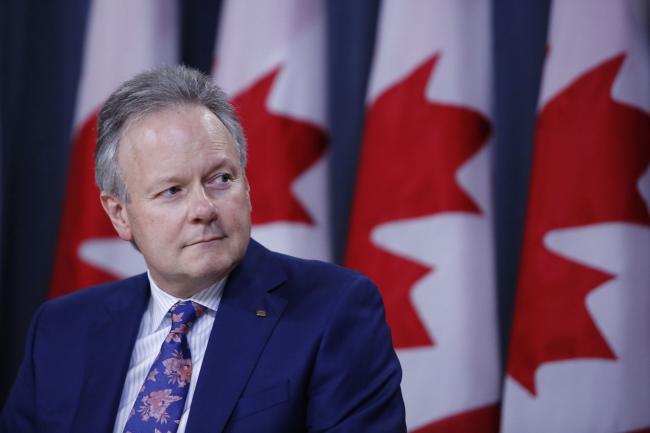(Bloomberg) -- The Bank of Canada forecast a weaker outlook for the domestic economy amid heightened global downside risks, potentially giving itself more leeway to lower borrowing costs.
In a decision Wednesday, policy makers kept their current 1.75% policy rate unchanged for an eighth straight meeting, calling the level “appropriate” even as they cut their growth forecasts for the next two years.
But there were changes to the statement compared with the one from September that suggest officials have become less confident in the face of a weakening global economy. These include removing explicit references to Canadian rates being stimulative and to the nation’s economy operating close to potential. Wednesday’s statement also referred to the recent gain in the country’s dollar.
The central bank “is mindful that the resilience of Canada’s economy will be increasingly tested as trade conflicts and uncertainty persist,” policy makers led by Governor Stephen Poloz said in the statement. “In considering the appropriate path for monetary policy, the Bank will be monitoring the extent to which the global slowdown spreads beyond manufacturing and investment.”
Neutral Stance
The statement and the fresh batch of more pessimistic growth forecasts will raise questions about the central bank’s commitment to a neutral stance on rates, particularly in the face of global easing in many other countries that has made the Bank of Canada an outlier. If the Federal Reserve lowers its interest rates later today, as expected, the Bank of Canada would have the highest policy rate in the industrialized world.
As recently as last month, Deputy Governor Larry Schembri used a speech to note the central bank’s confidence in Canada’s resiliency to negative global shocks.
Before the statement, investors were pricing in less than a 50% percent chance of a rate cut over the next 12 months. The Canadian dollar dropped on the statement, falling 0.4% to C$1.3137 per U.S. dollar at 10:05 a.m. in Toronto trading.
“Bank of Canada held its target overnight rate unchanged, as expected, but with a slightly more dovish tilt,” Brett House, deputy chief economist at Scotiabank, said by e-mail. “While not entirely setting up a cut at its next meeting, this leaves open the door a bit further for a December cut.”
The next rate decision is Dec. 4.
Trade Tensions
In contrast, the central bank on Wednesday highlighted the impact of trade conflicts and uncertainty on global growth which officials said is hurting business investment, exports and commodity prices, even with global monetary easing.
The bank lowered its growth forecast for Canada to 1.7% next year, from a July estimate of 1.9%, and 1.8% in 2021 from a previous projection of 2%. It also forecast an outright decline in exports and business investment in the second half of this year, when growth is expected to average a sluggish 1.3%.
As a result, the level of economic output will be “slightly lower” at the end of 2021 than predicted in July.
Officials also noted -- in a rare reference to the Canadian dollar in a rate statement -- that “despite” lower commodity prices, the currency hasn’t weakened against the U.S. dollar and is actually stronger against other currencies.
At the same time, the central bank is projecting inflation will remain at the 2% target over the projection horizon, in part because of a small downward revision to its estimates for potential growth and expectations the “modest” output gap -- primarily in oil-producing regions -- will narrow.
Global financial conditions meanwhile have eased, helping offset the impact of growing trade uncertainty, officials said.
More Bullish
The Bank of Canada was more bullish on consumption and housing -- which is being fueled by a robust labor market -- with forecasts little changed or even higher for those sectors in 2020 and 2021.
Another source of future growth could be additional stimulus from Prime Minister Justin Trudeau’s re-elected Liberal government, which has promised to implement new spending and tax cuts next year.
The Bank of Canada “will pay close attention to the sources of resilience in the Canadian economy -- notably consumer spending and housing activity -- as well as to fiscal policy developments,” policy makers said in the statement.
©2019 Bloomberg L.P.
